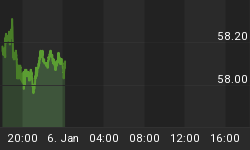The post March 2009 closing high for the Industrials occurred on April 29th at 12,810.54 and for the Transports that high occurred on July 7th at 5,618.25. This in turn left a Dow theory non-confirmation in place. This was then followed by a close below the March 2011 secondary low points on August 4th. As a result of this close, a Dow theory primary trend change occurred. This is the first such occurrence since the bear market rally out of the March 2009 lows began and I do not take this development lightly. But, at the same time, based on other technical factors, I also have to question this trend change.

I have seen it written by some, who apparently have not truly studied the Dow theory, that such a trend change is ominous and that it has long-term implications for the market. But, this is not always true as history shows otherwise. Statements like this are misleading for those that don't know better and show that one has not taken the time to actually study Dow theory. With this said, let's examine the facts and the rest of the story.
First, I want to make it perfectly clear that cycles and Dow theory are two completely different disciplines. Cycles merely provide us with a means to identify trends of like degree. We can then extract statistical data that is otherwise not available from a pure Dow theory perspective. By applying the statistical data we then have an edge that Dow theory alone does not offer.
Prior to 1921, a secular bull market, in accordance with Dow theory, was one and the same as the upside piece to the 4-year cycle and the secular bear market that followed was one and the same as the downside piece of the same 4-year cycle. It was with the secular bull market that began at the 1921 low that these secular bull and bear market periods, in accordance with Dow theory, began to grow to the point in which they included multiple 4-year cycles. The bull market period between 1921 and 1929 grew to the point in which it included two 4-year cycles. The next secular bull market, which ran between 1942 and 1966, grew to the point in which it included six 4-year cycles. The last great secular bull market, which ran between 1974 and 2007, grew even further and included eight 4-year cycles.
History shows us that prior to 1942 the bearish Dow theory trend changes occurred in conjunction with the conclusion of the secular bull market and served to confirm that the decline into the secular bear market had begun.
But, as the secular bull and bear market periods grew, we began to see Dow theory trend changes occur within the context of the longer-term trend. This was seen all throughout the 1940's, 50's and into the 1960's. There is no doubt that when this occurred, it was associated with important tops in the market, but none of them marked THE top of the longer-term trend. The leading Dow theorist of that time was E. George Schaefer and he recognized that the secular bull market had stretched in duration. As a result, Mr. Schaefer explained that he used "other technical studies," outside of traditional Dow theory to keep him on the right side of the market. So, while Mr. Schaefer thoroughly understood Dow theory, he also used other technical tools that were not a part of traditional Dow theory in order to filter the traditional Dow theory trend changes and he did this because he realized that the bull market periods had evolved beyond what they were in the days of Charles H. Dow, William Peter Hamilton and Robert Rhea.
I want to add that during the secular bull market period that ran between 1974 and 2007, there were also a number of traditional Dow theory trend changes that did not mark the top of the bull market then either. So, the fact is that history clearly shows us that Dow theory trend changes are not always ominous nor do they always set the longer-term trend for the market.
Like Mr. Schaefer, I feel that based on other technical studies/factors, which I have covered in the latest research letter, we must also filter, or at the very least, question the current Dow theory trend change. Yes, longer-term, my view that the rally out of the March 2009 low is a bear market rally remains the same. I also continue to believe that the phase II decline is ahead of us and that it will be worse than the phase I decline that occurred into the March 2009 low. But, there is not sufficient evidence at hand to say that the bear market rally has indeed run its course and there is sufficient evidence to say that Dow theory trend changes are not always ominous.
I have begun doing free market commentary that is available at www.cyclesman.net The specifics on Dow theory, my statistics, model expectations, and timing are available through a subscription to Cycles News & Views and the short-term updates. I have gone back to the inception of the Dow Jones Industrial Average in 1896 and identified the common traits associated with all major market tops. Thus, I know with a high degree of probability what this bear market rally top will look like and how to identify it. These details are covered in the monthly research letters as it unfolds. I also provide important turn point analysis using the unique Cycle Turn Indicator on the stock market, the dollar, bonds, gold, silver, oil, gasoline, the XAU and more. A subscription includes access to the monthly issues of Cycles News & Views covering the Dow theory, and very detailed statistical based analysis plus updates 3 times a week.
















